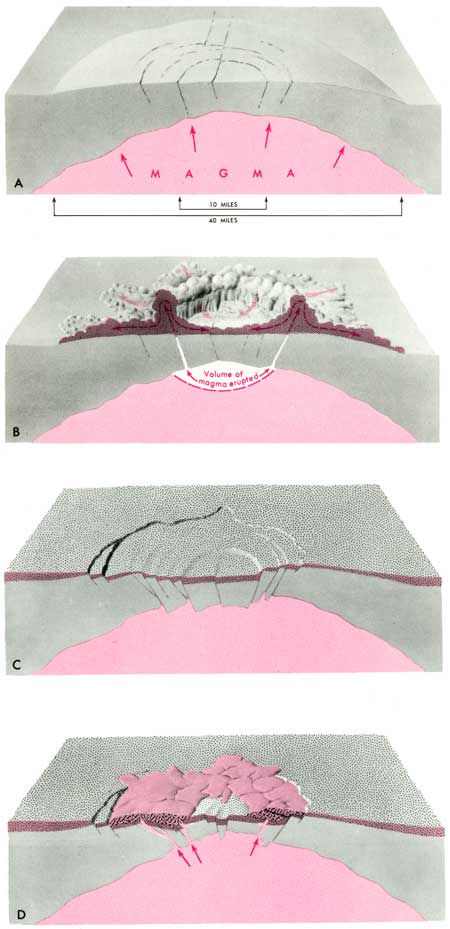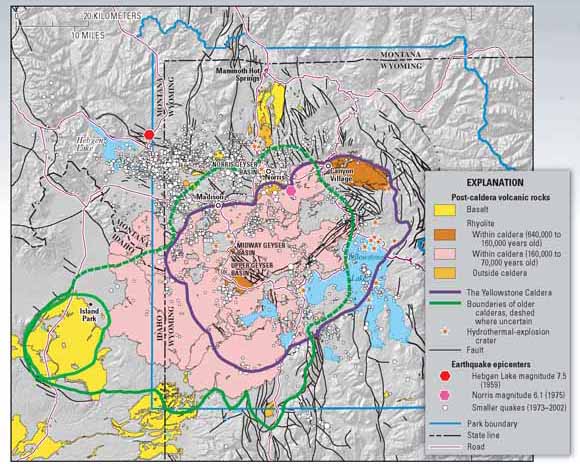
 Parking is located at the Madison Junction Ranger station. There is no container at this location.
Parking is located at the Madison Junction Ranger station. There is no container at this location.
The central portion of Yellowstone lies within one of the calderas of an active volcanic field. A caldera is formed following the removal of magma from a relatively shallow source either through eruption or withdrawal of the magma to a new reservoir. With out the support of the magma, the overlying rock collapses into the void left by the magma forming a typically circular depression.
 Calderas differ from craters in size and way they are form. Craters are smaller and are formed by the explosive removal of material.
Calderas differ from craters in size and way they are form. Craters are smaller and are formed by the explosive removal of material.
There are three calderas associated with the Yellowstone Volcanic field, each named after an eruption. The largest caldera, the Huckleberry Ridge Caldera (green on the image), extends from central Yellowstone west into Idaho and was formed about 2.1 million years ago. The second and smallest caldera, the Island Park Caldera (light green on the image), was formed about 1.3 million years ago and is actually outside of Yellowstone to the west. This small caldera lies within the Huckleberry Ridge Caldera. The most recent caldera, the Lava Creek Caldera or the Yellowstone Caldera (Purple on the image), formed about 630,000 years ago and also lies mostly within the Huckleberry Ridge Caldera, extending about 10 miles to the east. The image is clickable to bring up a larger picture.
It is this last caldera, the Yellowstone Caldera, that is most easily recognizable. It is over 45 miles long and 30 miles wide and thousands of feet deep. After this deep caldera was formed, rhyolitic lava filled the caldera.
 The ranger station lies near what is thought to be the rim of the caldera. From here the rim extends eastward to approximately Gibbon Falls and westward slowly curving into cliffs to the south. The cliffs to the north are composed of volcanic ash that settled on the outside of the caldera following an eruption approximately 600,000 years ago (See Tuff Cliff earthcache). The tall cliffs to the south are rhyolite formed by slow, viscous lava that filled the caldera after it formed (See Firehole Falls Earthcache)
The ranger station lies near what is thought to be the rim of the caldera. From here the rim extends eastward to approximately Gibbon Falls and westward slowly curving into cliffs to the south. The cliffs to the north are composed of volcanic ash that settled on the outside of the caldera following an eruption approximately 600,000 years ago (See Tuff Cliff earthcache). The tall cliffs to the south are rhyolite formed by slow, viscous lava that filled the caldera after it formed (See Firehole Falls Earthcache)
Please note that the other earthcaches mentioned above are still being written up and need to be reviewed by the NPS.
Logging requirements:
Send me a note with :
- The text "GC14G6A Yellowstone Caldera at Madison Junction" on the first line
- The number of people in your group.
- estimating the height of the rhyolite cliffs
- The rim of the crater curves south about 8 miles west of there. Hypothesize why the rim of the crater curves southward under the rhyolite cliffs
The above information was compiled from the following sources:
- Fritz, William J., Roadside Geology of the Yellowstone Country, Mountain Press Publishing Company, May 1989.
- Photo glossary of volcano terms; U.S. Department of the Interior, U.S. Geological Survey, Menlo Park, California, USA URL http://volcanoes.usgs.gov/Products/Pglossary/caldera.html
- The Geologic Story of Yellowstone National Park, William R. Keefer Illustrated by John R. Stacy, GEOLOGICAL SURVEY BULLETIN 1347 1975
- Steam Explosions, Earthquakes, and Volcanic Eruptions—What’s in Yellowstone’s Future? U.S. Geological Survey Fact Sheet 2005-3024 2005
Placement approved by the
Yellowstone National Park